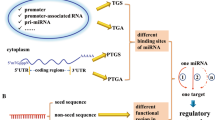Abstract
MicroRNAs are highly conserved small noncoding RNAs that can suppress protein translation through complementary binding to target mRNAs. We used a novel approach to identify miRNA targets in the protist Trichomonas vaginalis by comparing the levels of differentially expressed proteins and genes in the trophozoite and amoeboid stages. We observed that the T. vaginalis malate dehydrogenase (Tv_MDH) gene was upregulated 20-fold in the amoeboid stage, but the protein level was reduced by 4.5-fold. Bioinformatics analysis revealed that the Tv_MDH mRNA contains putative target sites of the miR-1 family. The expression level of endogenous tva-miR-1 in the amoeboid stage was 50-fold higher than in the trophozoite stage. Transfection of trophozoites with tva-miR-1 mimics reduced Tv_MDH protein expression by 60%. Based on these experimental data, we conclude that Tv_MDH is negatively regulated by tva-miR-1. The results of this study demonstrate that a combination of proteomic and transcriptomic approaches is a powerful tool for identifying miRNA targets.




Similar content being viewed by others
References
Bagga S, Bracht J et al (2005) Regulation by let-7 and lin-4 miRNAs results in target mRNA degradation. Cell 122(4):553–563
Bartel DP (2004) MicroRNAs: genomics, biogenesis, mechanism, and function. Cell 116(2):281–297
Bruneau BG (2005) Developmental biology: tiny brakes for a growing heart. Nature 436(7048):181–182
Carlton JM, Hirt RP et al (2007) Draft genome sequence of the sexually transmitted pathogen Trichomoinas vaginalis. Science 315(5809):207–212
Chen JF, Mandel EM et al (2006) The role of microRNA-1 and microRNA-133 in skeletal muscle proliferation and differentiation. Nat Genet 38(2):228–233
Crouch ML, Alderete JF (1999) Trichomonas vaginalis interactions with fibronectin and laminin. Microbiology 145(Pt 10):2835–2843
Diamond LS, Clark CG et al (1995) YI-S, a casein-free medium for axenic cultivation of Entamoeba histolytica, related Entamoeba, Giardia intestinalis and Trichomonas vaginalis. J Eukaryot Microbiol 42(3):277–278
Grad Y, Aach J et al (2003) Computational and experimental identification of C. elegans microRNAs. Mol Cell 11(5):1253–1263
Griffiths-Jones S, Saini HK et al (2008) miRBase: tools for microRNA genomics. Nucleic Acids Res 36(Database issue):D154–D158
Grimson A, Farh KK et al (2007) MicroRNA targeting specificity in mammals: determinants beyond seed pairing. Mol Cell 27(1):91–105
Huang KY, Chien KY et al (2009) A proteome reference map of Trichomonas vaginalis. Parasitol Res 104(4):927–933
Krek A, Grun D et al (2005) Combinatorial microRNA target predictions. Nat Genet 37(5):495–500
Lagos-Quintana M, Rauhut R et al (2002) Identification of tissue-specific microRNAs from mouse. Curr Biol 12(9):735–739
Lewis BP, Shih IH et al (2003) Prediction of mammalian microRNA targets. Cell 115(7):787–798
Lim LP, Lau NC et al (2005) Microarray analysis shows that some microRNAs downregulate large numbers of target mRNAs. Nature 433(7027):769–773
McCarthy JJ, Esser KA (2007) MicroRNA-1 and microRNA-133a expression are decreased during skeletal muscle hypertrophy. J Appl Physiol 102(1):306–313
Miranda KC, Huynh T et al (2006) A pattern-based method for the identification of MicroRNA binding sites and their corresponding heteroduplexes. Cell 126(6):1203–1217
Papadopoulos GL, Reczko M et al (2009) The database of experimentally supported targets: a functional update of TarBase. Nucleic Acids Res 37(Database issue):D155–D158
Rajewsky N (2006) microRNA target predictions in animals. Nat Genet 38 Suppl:S8–S13
Rao PK, Kumar RM et al (2006) Myogenic factors that regulate expression of muscle-specific microRNAs. Proc Natl Acad Sci U S A 103(23):8721–8726
Safdar A, Abadi A et al (2009) miRNA in the regulation of skeletal muscle adaptation to acute endurance exercise in C57Bl/6 J male mice. PLoS ONE 4(5):e5610
Saraiya AA, Wang CC (2008) snoRNA, a novel precursor of microRNA in Giardia lamblia. PLoS Pathog 4(11):e1000224
Selbach M, Schwanhausser B et al (2008) Widespread changes in protein synthesis induced by microRNAs. Nature 455(7209):58–63
Sokol NS, Ambros V (2005) Mesodermally expressed Drosophila microRNA-1 is regulated by Twist and is required in muscles during larval growth. Genes Dev 19(19):2343–2354
Lin W-C, Li S-C et al (2009) Identification of microRNA in the protist Trichomonas vaginalis. Genomics 93(5):487–493
Xu C, Lu Y et al (2007) The muscle-specific microRNAs miR-1 and miR-133 produce opposing effects on apoptosis by targeting HSP60, HSP70 and caspase-9 in cardiomyocytes. J Cell Sci 120(Pt 17):3045–3052
Yu XY, Song YH et al (2008) Glucose induces apoptosis of cardiomyocytes via microRNA-1 and IGF-1. Biochem Biophys Res Commun 376(3):548–552
Zhao Y, Samal E et al (2005) Serum response factor regulates a muscle-specific microRNA that targets Hand2 during cardiogenesis. Nature 436(7048):214–220
Acknowledgements
Funding for this project was provided by the Chang Gung Memorial Hospital (CMRPD170481), the National Science Council (NSC-97-2320-B-182-011-MY3), and the Ministry of Education, Taiwan, ROC to Chang Gung University.
Author information
Authors and Affiliations
Corresponding author
Rights and permissions
About this article
Cite this article
Lin, WC., Huang, KY., Chen, SC. et al. Malate dehydrogenase is negatively regulated by miR-1 in Trichomonas vaginalis . Parasitol Res 105, 1683–1689 (2009). https://doi.org/10.1007/s00436-009-1616-5
Received:
Accepted:
Published:
Issue Date:
DOI: https://doi.org/10.1007/s00436-009-1616-5




